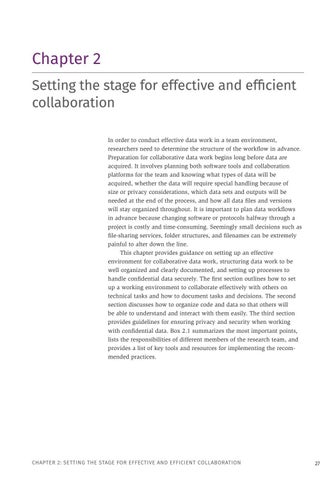Chapter 2 Setting the stage for effective and efficient collaboration In order to conduct effective data work in a team environment, researchers need to determine the structure of the workflow in advance. Preparation for collaborative data work begins long before data are acquired. It involves planning both software tools and collaboration platforms for the team and knowing what types of data will be acquired, whether the data will require special handling because of size or privacy considerations, which data sets and outputs will be needed at the end of the process, and how all data files and versions will stay organized throughout. It is important to plan data workflows in advance because changing software or protocols halfway through a project is costly and time-consuming. Seemingly small decisions such as file-sharing services, folder structures, and filenames can be extremely painful to alter down the line. This chapter provides guidance on setting up an effective environment for collaborative data work, structuring data work to be well organized and clearly documented, and setting up processes to handle confidential data securely. The first section outlines how to set up a working environment to collaborate effectively with others on technical tasks and how to document tasks and decisions. The second section discusses how to organize code and data so that others will be able to understand and interact with them easily. The third section provides guidelines for ensuring privacy and security when working with confidential data. Box 2.1 summarizes the most important points, lists the responsibilities of different members of the research team, and provides a list of key tools and resources for implementing the recommended practices.
CHAPTER 2: SETTING THE STAGE FOR EFFECTIVE AND EFFICIENT COLLABORATION
27





